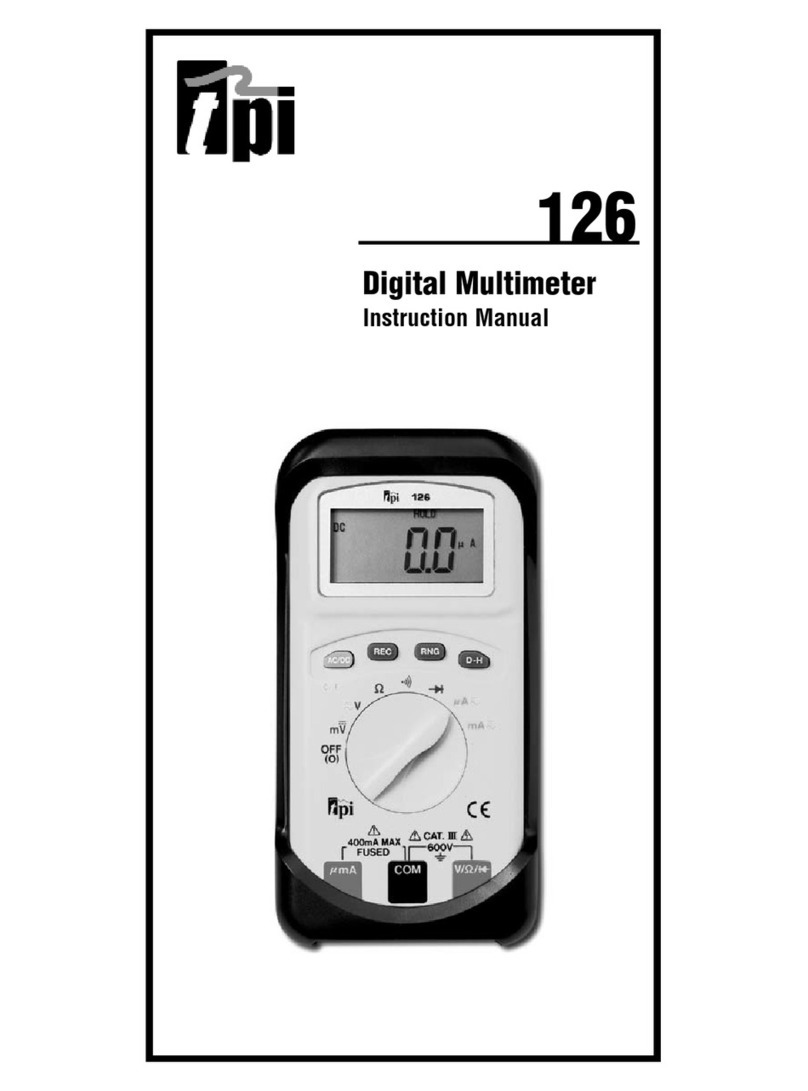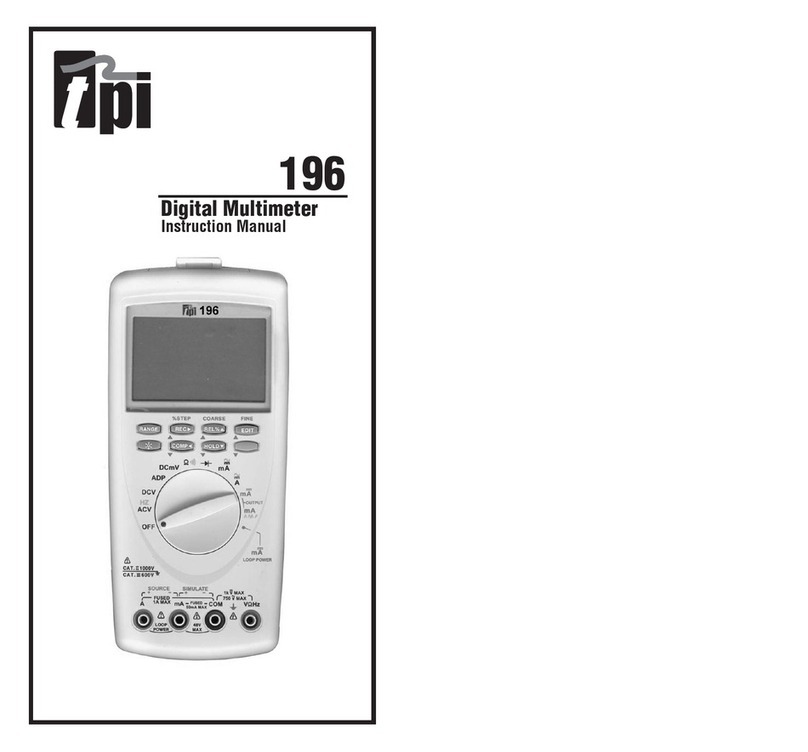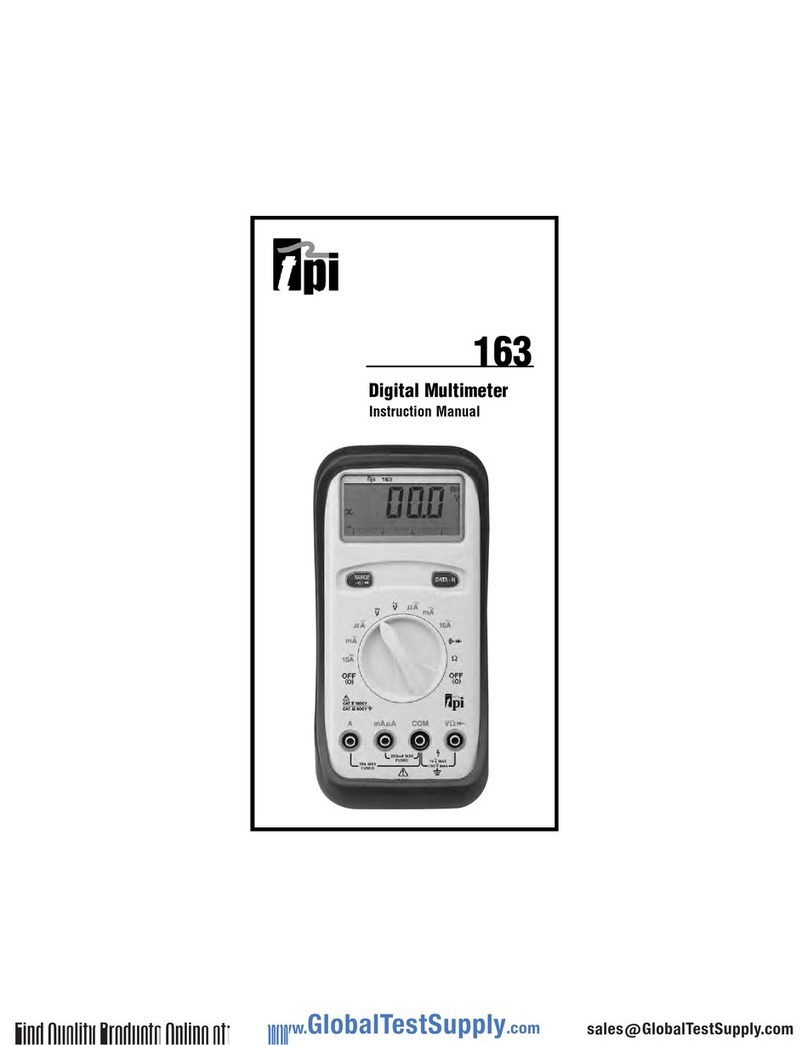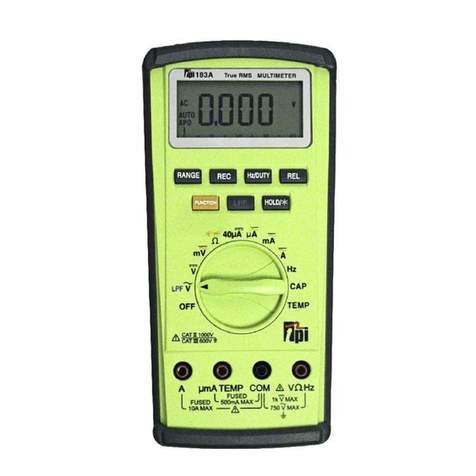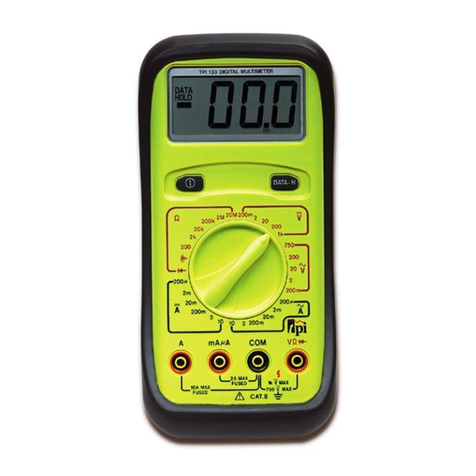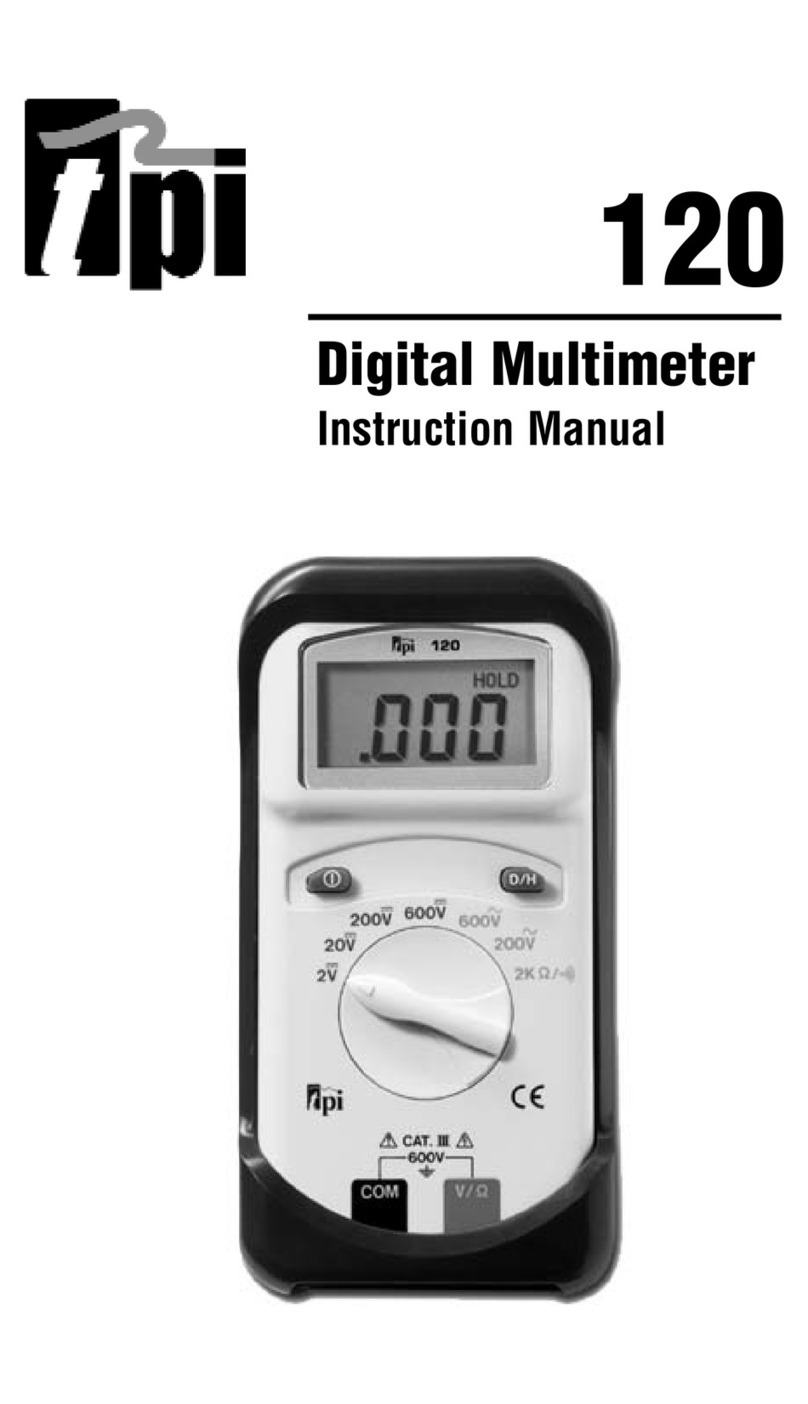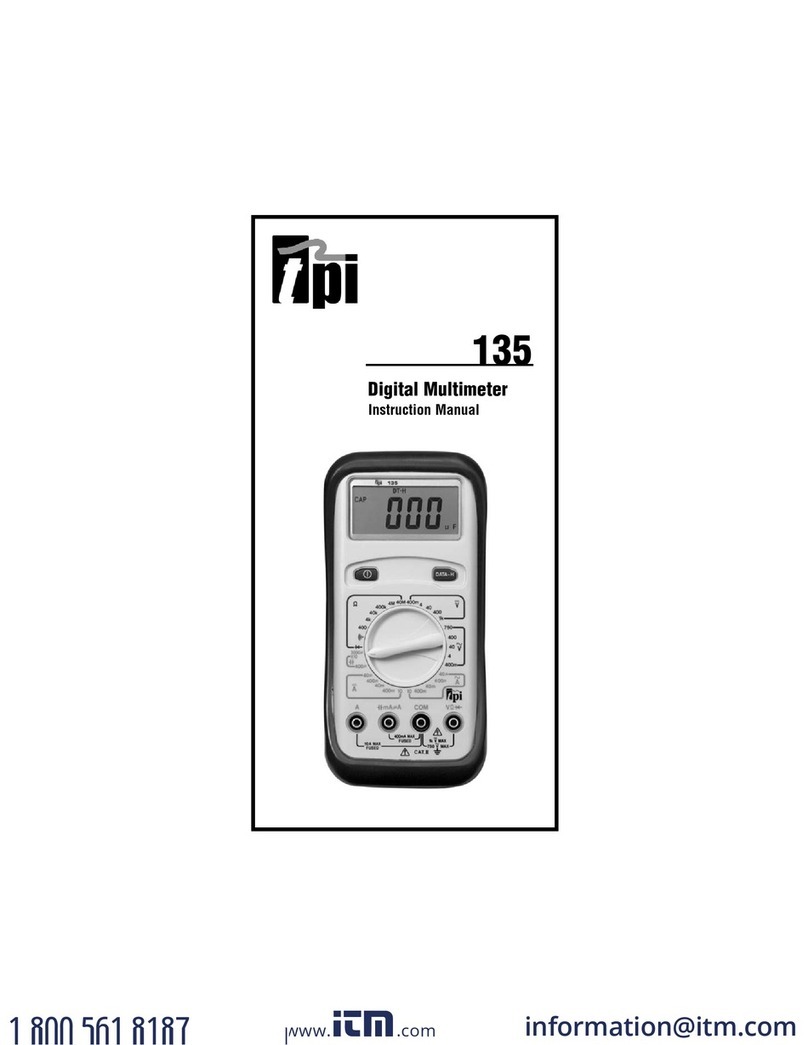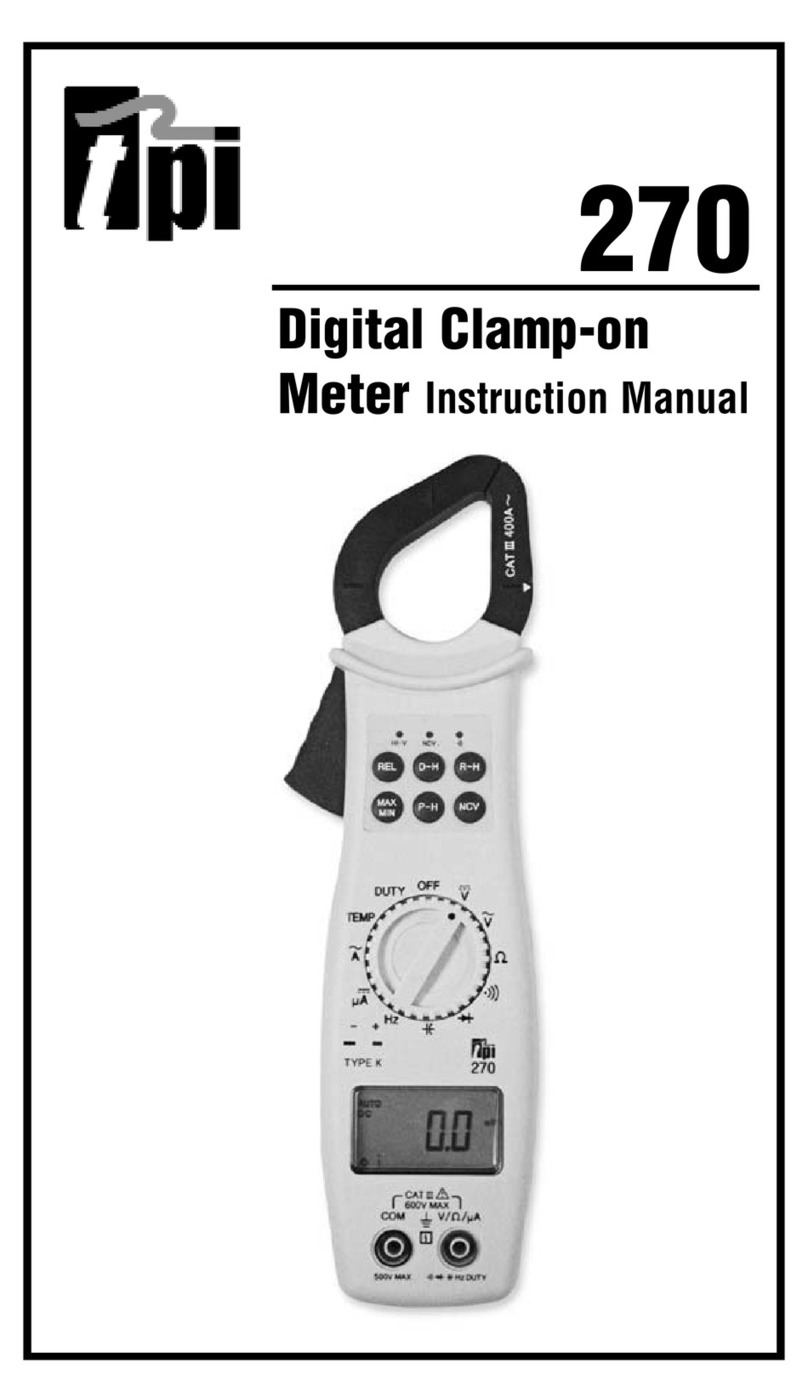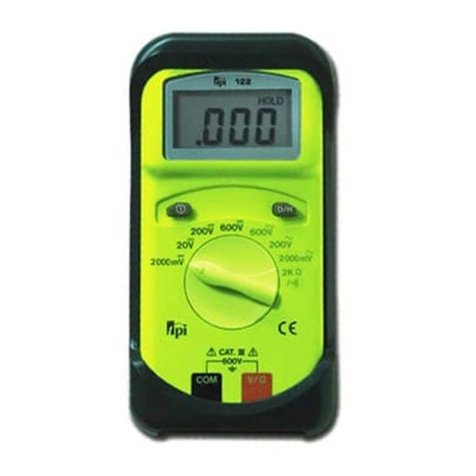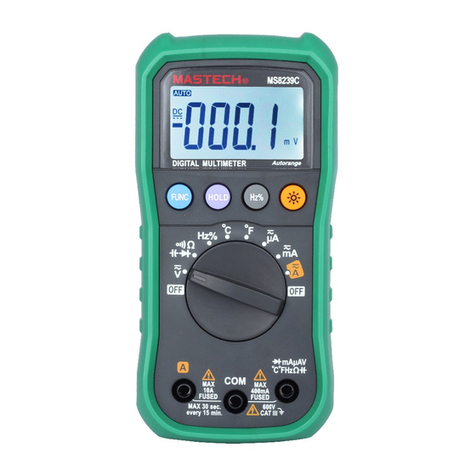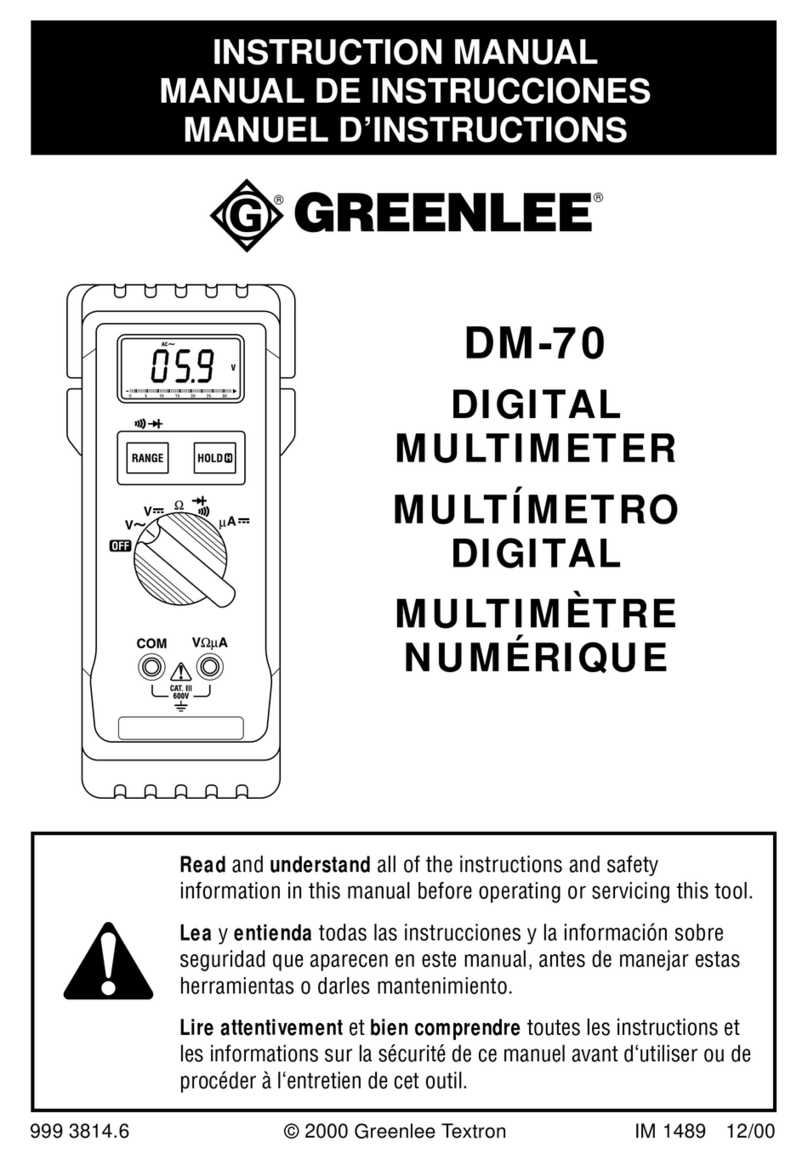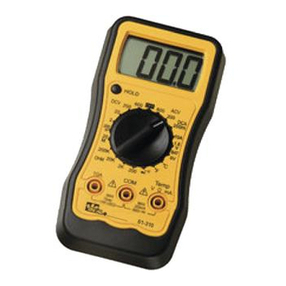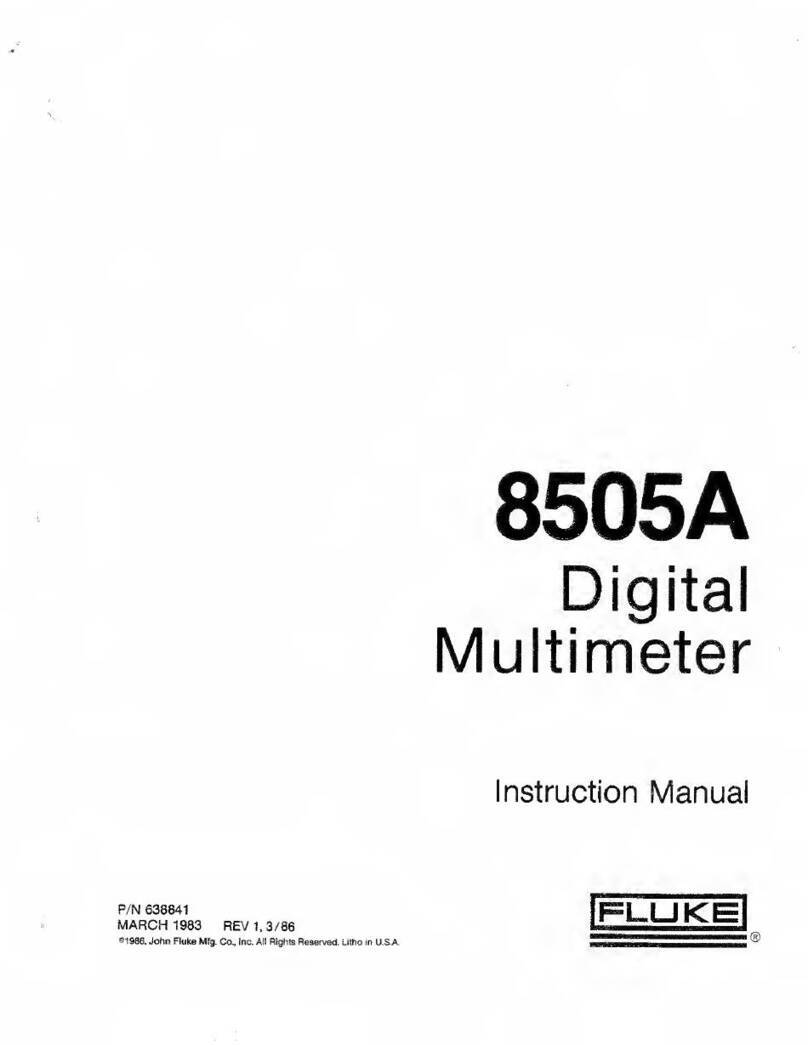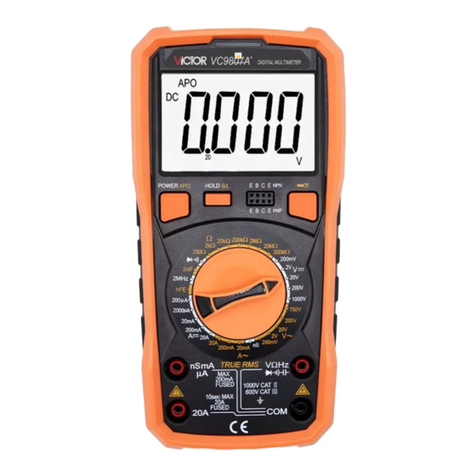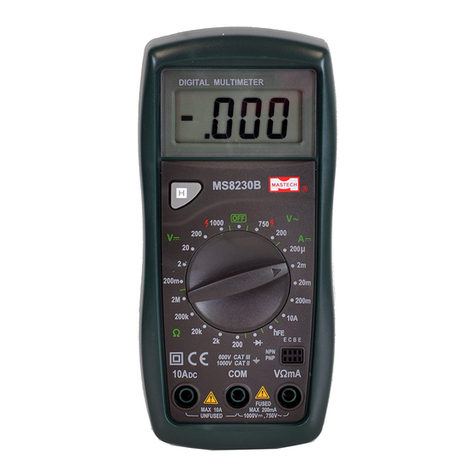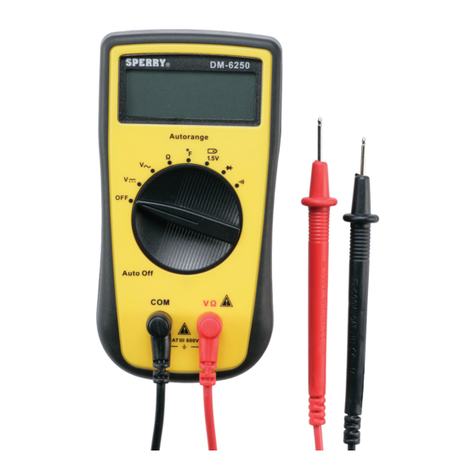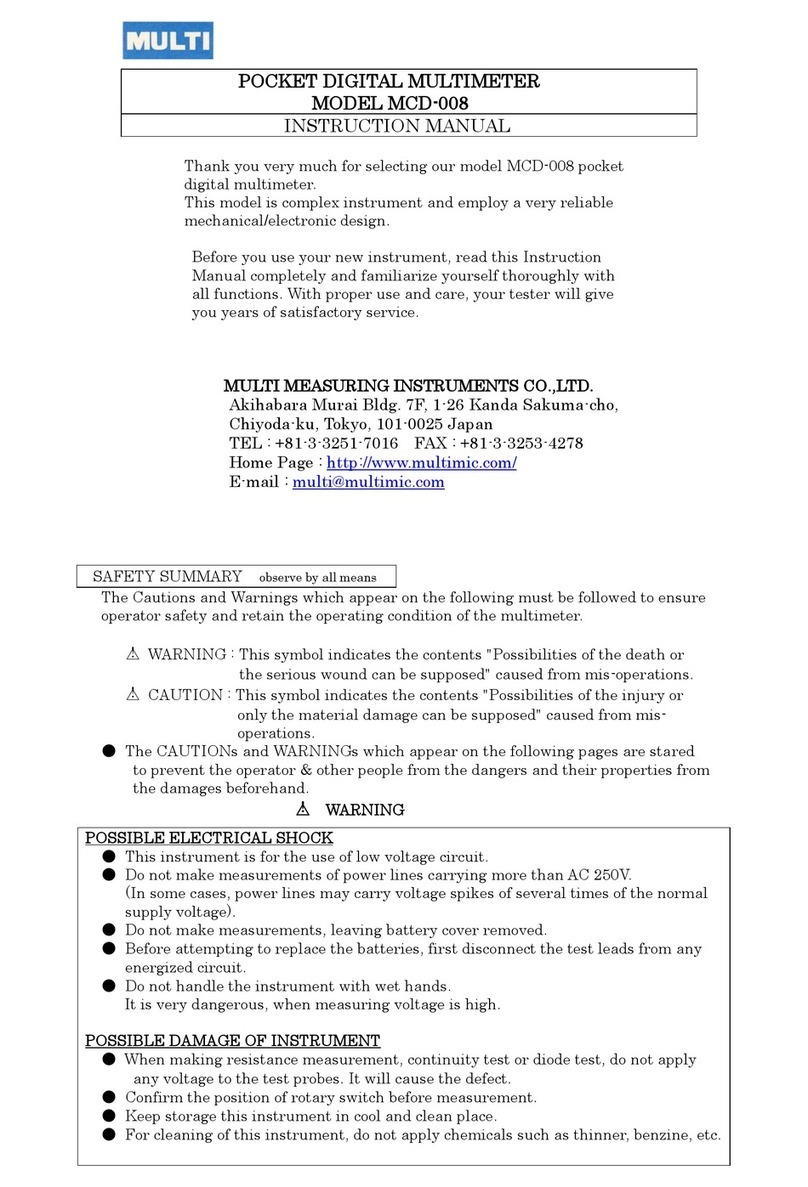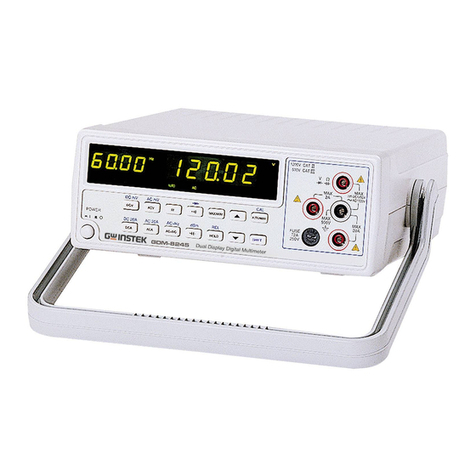TPI 183 User manual

183
Digital Multimeter
Instruction Manual

2 3
A. INTRODUCTION
1. Congratulations!!
Thank you for purchasing a TPI Digital Multimeter. The
Triple Display 183 is an innovative new concept in DMM
design. The uni ue display enables you to view more than
one event at a time. This eliminates the hassle of switching
back and forth to review minimum, maximum or preset
comparative values. The meter is also easy to use and built
to last. The 183 is covered by a 3 Year Limited Warranty.
2. Product Description
The 183 is a hand-held autoranging DMM. The backlit LCD
can display three readings at one time. In addition to basic
functions of ACV, DCV, ACA, DCA, , Diode Test and
Continuity, the 183 measures Fre uency (Hz) and
Capacitance. The 183 also has RS232 output and software
for recording information into a PC.
The 183 also features:
•REC Records Min/Max and Average readings during
specified measurement intervals. Time refer-
ence can also be displayed to determine when
the values were recorded.
•COMP Compare actual reading to preset HI and LOW
values for Pass/Fail testing of components.
•OLD Two-hold system automatically holds the
previous stable reading when a new one is
obtained.
The 183 comes complete with the following
accessories:
Battery
Rubber Boot
Test Lead Set
Instruction Manual
TABLE OF CONTENTS
page
A. INTRODUCTION
1. Congratulations . . . . . . . . . . . . . . . . . . . . .3
2. Product Description . . . . . . . . . . . . . . . . . .3
3. EC Declaration of Conformity . . . . . . . . . . .4
B. SAFETY CONSIDERATIONS . . . . . . . . . . . . . . . .5
C. TEC NICAL DATA
1. Features and Benefits . . . . . . . . . . . . . . . . .7
2. Product Applications . . . . . . . . . . . . . . . . .8
3. Specifications . . . . . . . . . . . . . . . . . . . . . .9
D. MEASUREMENT TEC NIQUES
1. Controls and Functions . . . . . . . . . . . . . . . . . .12
a) Disable Auto Power Off . . . . . . . . . .13
b) Activating PC Communications . . . .13
2. Step by Step Procedures:
a) Measuring DC Volts . . . . . . . . . . . . .15
b) Measuring AC Volts . . . . . . . . . . . . .17
c) Measuring DC Amps . . . . . . . . . . . .18
d) Measuring AC Amps . . . . . . . . . . . .20
e) Measuring Resistance . . . . . . . . . . .21
f) Measuring Diodes . . . . . . . . . . . . . .22
g) Continuity Buzzer . . . . . . . . . . . . . .23
h) Measuring Capacitance . . . . . . . . . .24
i) Measuring Fre uency . . . . . . . . . . .25
j) Record Mode . . . . . . . . . . . . . . . . .26
k) Compare Mode . . . . . . . . . . . . . . . .27
l) Relative % Mode . . . . . . . . . . . . . . .28
m) Two-Hold System . . . . . . . . . . . . . .29
n) RS-232C Interface . . . . . . . . . . . . . .30
E. ACCESSORIES . . . . . . . . . . . . . . . . . . . . . . . .32
F. MAINTENANCE . . . . . . . . . . . . . . . . . . . . . . . .33
G. TROUBLE S OOTING GUIDE . . . . . . . . . . . . . .34

2 3
A. INTRODUCTION
1. Congratulations!!
Thank you for purchasing a TPI Digital Multimeter. The
Triple Display 183 is an innovative new concept in DMM
design. The uni ue display enables you to view more than
one event at a time. This eliminates the hassle of switching
back and forth to review minimum, maximum or preset
comparative values. The meter is also easy to use and built
to last. The 183 is covered by a 3 Year Limited Warranty.
2. Product Description
The 183 is a hand-held autoranging DMM. The backlit LCD
can display three readings at one time. In addition to basic
functions of ACV, DCV, ACA, DCA, , Diode Test and
Continuity, the 183 measures Fre uency (Hz) and
Capacitance. The 183 also has RS232 output and software
for recording information into a PC.
The 183 also features:
•REC Records Min/Max and Average readings during
specified measurement intervals. Time refer-
ence can also be displayed to determine when
the values were recorded.
•COMP Compare actual reading to preset HI and LOW
values for Pass/Fail testing of components.
•OLD Two-hold system automatically holds the
previous stable reading when a new one is
obtained.
The 183 comes complete with the following
accessories:
Battery
Rubber Boot
Test Lead Set
Instruction Manual
TABLE OF CONTENTS
page
A. INTRODUCTION
1. Congratulations . . . . . . . . . . . . . . . . . . . . .3
2. Product Description . . . . . . . . . . . . . . . . . .3
3. EC Declaration of Conformity . . . . . . . . . . .4
B. SAFETY CONSIDERATIONS . . . . . . . . . . . . . . . .5
C. TEC NICAL DATA
1. Features and Benefits . . . . . . . . . . . . . . . . .7
2. Product Applications . . . . . . . . . . . . . . . . .8
3. Specifications . . . . . . . . . . . . . . . . . . . . . .9
D. MEASUREMENT TEC NIQUES
1. Controls and Functions . . . . . . . . . . . . . . . . . .12
a) Disable Auto Power Off . . . . . . . . . .13
b) Activating PC Communications . . . .13
2. Step by Step Procedures:
a) Measuring DC Volts . . . . . . . . . . . . .15
b) Measuring AC Volts . . . . . . . . . . . . .17
c) Measuring DC Amps . . . . . . . . . . . .18
d) Measuring AC Amps . . . . . . . . . . . .20
e) Measuring Resistance . . . . . . . . . . .21
f) Measuring Diodes . . . . . . . . . . . . . .22
g) Continuity Buzzer . . . . . . . . . . . . . .23
h) Measuring Capacitance . . . . . . . . . .24
i) Measuring Fre uency . . . . . . . . . . .25
j) Record Mode . . . . . . . . . . . . . . . . .26
k) Compare Mode . . . . . . . . . . . . . . . .27
l) Relative % Mode . . . . . . . . . . . . . . .28
m) Two-Hold System . . . . . . . . . . . . . .29
n) RS-232C Interface . . . . . . . . . . . . . .30
E. ACCESSORIES . . . . . . . . . . . . . . . . . . . . . . . .32
F. MAINTENANCE . . . . . . . . . . . . . . . . . . . . . . . .33
G. TROUBLE S OOTING GUIDE . . . . . . . . . . . . . .34

5
B. SAFETY CONSIDERATIONS
WARNING: Please follow manufacturers test
procedures whenever possible. Do not attempt to
measure unknown voltages or components until a
complete understanding of the circuit is obtained.
GENERAL GUIDELINES
ALWAYS
• Test the 183 before using to make sure it is
operating properly.
• Inspect the test leads before using to make sure there
are no breaks or shorts.
• Double check all connections before testing.
• Have someone check on you periodically if working
alone.
• Have a complete understanding of the circuit being
measured.
• Disconnect power to circuit, then connect test leads
to the 183, and then to circuit being measured.
NEVER
• Attempt to measure unknown high voltages.
• Attempt to measure current with the meter in parallel
to the circuit.
• Connect the test leads to a live circuit before setting
up the instrument.
• Touch any exposed metal part of the test lead
assembly.
4
3. EC Declaration of Conformity
This is to certify that model 183 conforms to the protection
re uirements of the council directive 89/336/EEC, in the
approximation of laws of the member states relating to
Electromagnetic compatibility and 73/23/EEC, The Low
Voltage Directive by application of the following standards:
EN 50081-1 1992 Emissions Standard
EN 50082-1 1992 Immunity Standard
EN61010-1 1993 Safety Standard
EN61010-2-031 1995 Safety Standard
To ensure conformity with these standards, this instrument
must be operated in accordance with the instructions and
specifications given in this manual.
CAUTION:
Even though this instrument complies with the
immunity standards, the accuracy can be affected
by strong radio emissions not covered in the
above standards. Sources such as hand held radio
transceivers, radio and TV transmitters, vehicle
radios and cellular phones generate electromag-
netic radiation that could be induced into the test
leads of this instrument. Care should be taken to
avoid such situations or alternatively, check to
make sure that the instrument is not being
influenced by these emissions.

5
B. SAFETY CONSIDERATIONS
WARNING: Please follow manufacturers test
procedures whenever possible. Do not attempt to
measure unknown voltages or components until a
complete understanding of the circuit is obtained.
GENERAL GUIDELINES
ALWAYS
• Test the 183 before using to make sure it is
operating properly.
• Inspect the test leads before using to make sure there
are no breaks or shorts.
• Double check all connections before testing.
• Have someone check on you periodically if working
alone.
• Have a complete understanding of the circuit being
measured.
• Disconnect power to circuit, then connect test leads
to the 183, and then to circuit being measured.
NEVER
• Attempt to measure unknown high voltages.
• Attempt to measure current with the meter in parallel
to the circuit.
• Connect the test leads to a live circuit before setting
up the instrument.
• Touch any exposed metal part of the test lead
assembly.
4
3. EC Declaration of Conformity
This is to certify that model 183 conforms to the protection
re uirements of the council directive 89/336/EEC, in the
approximation of laws of the member states relating to
Electromagnetic compatibility and 73/23/EEC, The Low
Voltage Directive by application of the following standards:
EN 50081-1 1992 Emissions Standard
EN 50082-1 1992 Immunity Standard
EN61010-1 1993 Safety Standard
EN61010-2-031 1995 Safety Standard
To ensure conformity with these standards, this instrument
must be operated in accordance with the instructions and
specifications given in this manual.
CAUTION:
Even though this instrument complies with the
immunity standards, the accuracy can be affected
by strong radio emissions not covered in the
above standards. Sources such as hand held radio
transceivers, radio and TV transmitters, vehicle
radios and cellular phones generate electromag-
netic radiation that could be induced into the test
leads of this instrument. Care should be taken to
avoid such situations or alternatively, check to
make sure that the instrument is not being
influenced by these emissions.

5
B. SAFETY CONSIDERATIONS
WARNING: Please follow manufacturers test
procedures whenever possible. Do not attempt to
measure unknown voltages or components until a
complete understanding of the circuit is obtained.
GENERAL GUIDELINES
ALWAYS
• Test the 183 before using to make sure it is
operating properly.
• Inspect the test leads before using to make sure there
are no breaks or shorts.
• Double check all connections before testing.
• Have someone check on you periodically if working
alone.
• Have a complete understanding of the circuit being
measured.
• Disconnect power to circuit, then connect test leads
to the 183, and then to circuit being measured.
NEVER
• Attempt to measure unknown high voltages.
• Attempt to measure current with the meter in parallel
to the circuit.
• Connect the test leads to a live circuit before setting
up the instrument.
• Touch any exposed metal part of the test lead
assembly.
4
3. EC Declaration of Conformity
This is to certify that model 183 conforms to the protection
re uirements of the council directive 89/336/EEC, in the
approximation of laws of the member states relating to
Electromagnetic compatibility and 73/23/EEC, The Low
Voltage Directive by application of the following standards:
EN 50081-1 1992 Emissions Standard
EN 50082-1 1992 Immunity Standard
EN61010-1 1993 Safety Standard
EN61010-2-031 1995 Safety Standard
To ensure conformity with these standards, this instrument
must be operated in accordance with the instructions and
specifications given in this manual.
CAUTION:
Even though this instrument complies with the
immunity standards, the accuracy can be affected
by strong radio emissions not covered in the
above standards. Sources such as hand held radio
transceivers, radio and TV transmitters, vehicle
radios and cellular phones generate electromag-
netic radiation that could be induced into the test
leads of this instrument. Care should be taken to
avoid such situations or alternatively, check to
make sure that the instrument is not being
influenced by these emissions.

76
INTERNATIONAL SYMBOLS
CAUTION: RISK OF ELECTRIC S OCK
AC (ALTERNATING CURRENT)
DC (DIRECT CURRENT)
REFER TO INSTRUCTION MANUAL
GROUND
FUSE
DOUBLE INSULATION
C. TEC NICAL DATA
1. Features and Benefits
Safety Meets CE and IEC 1010 re uirements.
UL Listed to U.S. and Canadian Safety
Standards.
True RMS Needed to accurately measure non-sinu-
soidal AC voltage and current waveforms
found on many controls and circuits.
Triple Display Shows more than one reading simultaneously.
Analog Bar Shows rapidly changing input signals
Graph that the normal display will not.
Two- old Holds two readings on the display at
System the same time.
Auto Off Automatically powers instrument off after 30
minutes of inactivity. Pressing any push
button or turning the rotary switch returns
the 183 to normal.
Record Records Min/Max and Average values. Time
reference when value was obtained.
Compare Compares stored value with measured value
for matching components.
Relative Displays measured value as a % of stored
Percentage value for checking component tolerances.
RS232 Output Transfers data directly to a PC while measuring.
Back Light Allows viewing in any light condition.
Autorange Automatically selects the best range for
the measurement.

76
INTERNATIONAL SYMBOLS
CAUTION: RISK OF ELECTRIC S OCK
AC (ALTERNATING CURRENT)
DC (DIRECT CURRENT)
REFER TO INSTRUCTION MANUAL
GROUND
FUSE
DOUBLE INSULATION
C. TEC NICAL DATA
1. Features and Benefits
Safety Meets CE and IEC 1010 re uirements.
UL Listed to U.S. and Canadian Safety
Standards.
True RMS Needed to accurately measure non-sinu-
soidal AC voltage and current waveforms
found on many controls and circuits.
Triple Display Shows more than one reading simultaneously.
Analog Bar Shows rapidly changing input signals
Graph that the normal display will not.
Two- old Holds two readings on the display at
System the same time.
Auto Off Automatically powers instrument off after 30
minutes of inactivity. Pressing any push
button or turning the rotary switch returns
the 183 to normal.
Record Records Min/Max and Average values. Time
reference when value was obtained.
Compare Compares stored value with measured value
for matching components.
Relative Displays measured value as a % of stored
Percentage value for checking component tolerances.
RS232 Output Transfers data directly to a PC while measuring.
Back Light Allows viewing in any light condition.
Autorange Automatically selects the best range for
the measurement.

98
3. Specifications
IEC 1010 Over Voltage:
CAT II - 1000V
CAT III - 600V
Pollution Degree 2
a. DCV
Range Resolution Accuracy Impedance
400mV 0.1mV ±0.3% of reading, 10MΩ
4V 0.001V ±2 digits
40V 0.01V
400V 0.1V
1000V 1V
b1. ACV (45 z to 450 z)
Range Resolution Accuracy Impedance
4V 0.001V ±0.75% of reading, 10MΩ
40V 0.01V ±5 digits
400V 0.1V
750V 1V
b2. ACV (450 z to 5k z)
Range Resolution Accuracy Impedance
4V 0.001V unspecified 10MΩ
40V 0.01V ±2% of reading,
400V 0.1V ±5 digits
750V 1V
b3. ACV (5k z to 20k z)
Range Resolution Accuracy Impedance
4V 0.001V unspecified 10MΩ
40V 0.01V ±2.5% of reading,
400V 0.1V ±5 digits
750V 1V unspecified
2. Product Applications
Perform the following tests and/or measurements
with the TPI 183 and the appropriate function:
VAC/R
DCmV • Thermocouples in furnaces or gas
applications.
ACA • Heat anticipator current in thermostats.
ACV • Line voltage.
ACV or DCV • Control circuit voltage.
DCµA • Flame safeguard control current.
O MS • Heating element resistance (continuity).
O MS • Compressor winding resistance.
O MS • Contactor and relay coil resistance.
O MS • Continuity of wiring.
CAP • Motor start and run capacitance.
z/FREQ • Fre uency on controls and line voltage.
REC • Record min/max voltage of controls and line
voltages.
DCmV • Temperature with optional temperature
adapter (A310).
ALL • Bar graph to indicate rapid fluctuations in
measurements.
ELECTRICAL
ACV • Measure line voltage.
O MS • Continuity of circuit breakers.
z/FREQ • Fre uency of line and control voltage.
DCV • Voltage of direct drive DC motors.
ELECTRONIC
ACV • Measure power supply voltage.
O MS • Continuity of circuit breakers.
REL% • Match components
COMP • Compare readings in circuits or components
z/FREQ • Fre uency of line and control voltage.
UL 3111-1

98
3. Specifications
IEC 1010 Over Voltage:
CAT II - 1000V
CAT III - 600V
Pollution Degree 2
a. DCV
Range Resolution Accuracy Impedance
400mV 0.1mV ±0.3% of reading, 10MΩ
4V 0.001V ±2 digits
40V 0.01V
400V 0.1V
1000V 1V
b1. ACV (45 z to 450 z)
Range Resolution Accuracy Impedance
4V 0.001V ±0.75% of reading, 10MΩ
40V 0.01V ±5 digits
400V 0.1V
750V 1V
b2. ACV (450 z to 5k z)
Range Resolution Accuracy Impedance
4V 0.001V unspecified 10MΩ
40V 0.01V ±2% of reading,
400V 0.1V ±5 digits
750V 1V
b3. ACV (5k z to 20k z)
Range Resolution Accuracy Impedance
4V 0.001V unspecified 10MΩ
40V 0.01V ±2.5% of reading,
400V 0.1V ±5 digits
750V 1V unspecified
2. Product Applications
Perform the following tests and/or measurements
with the TPI 183 and the appropriate function:
VAC/R
DCmV • Thermocouples in furnaces or gas
applications.
ACA • Heat anticipator current in thermostats.
ACV • Line voltage.
ACV or DCV • Control circuit voltage.
DCµA • Flame safeguard control current.
O MS • Heating element resistance (continuity).
O MS • Compressor winding resistance.
O MS • Contactor and relay coil resistance.
O MS • Continuity of wiring.
CAP • Motor start and run capacitance.
z/FREQ • Fre uency on controls and line voltage.
REC • Record min/max voltage of controls and line
voltages.
DCmV • Temperature with optional temperature
adapter (A310).
ALL • Bar graph to indicate rapid fluctuations in
measurements.
ELECTRICAL
ACV • Measure line voltage.
O MS • Continuity of circuit breakers.
z/FREQ • Fre uency of line and control voltage.
DCV • Voltage of direct drive DC motors.
ELECTRONIC
ACV • Measure power supply voltage.
O MS • Continuity of circuit breakers.
REL% • Match components
COMP • Compare readings in circuits or components
z/FREQ • Fre uency of line and control voltage.
UL 3111-1

10
g. Continuity Buzzer
Test Voltage Threshold Over Load Protection
3V 1000 digits 600 V DC or Peak AC
h. Capacitance
Range Resolution Accuracy Over Load Protection
10µF 0.01µF ±2% of reading, 600V DC or
100µF 0.1µF ±5 digits Peak AC
1000µF 1µF
10,000µF 1µF ±3% of reading, ±7 digits
i. Frequency
Range Resolution Accuracy Over Load Protection
200.00Hz 0.01Hz ±0.05% of reading, 600V DC or
2.0000kHz 0.0001kHz ±2 digits Peak AC
20.000kHz 0.001kHz
200.00kHz 0.01kHz
l. General Specifications
Max. Volt. between 1000V
any Input and Ground
Fuse Protection mA: 0.5Amp/600VAC; A: 10Amp/600VAC
Display Type, Digital: 4,000 Count, 4 times per second update
Analog: 2x41 segments, 20 times per sec. update
Operating Temp. -0° to 40°C (32° to 113°F)
Storage Temp. -20° to 60°C (-4° to 140°F)
Relative umidity 0% to 80%: (0° - 35°C/32° - 95°F)
0% to 70%: (35° - 55°C/95° - 131°F)
Temp. Coefficient 0.1 x (Specified Accuracy) per °C for
temperature <18°C to >28°C
Power Supply 9 Volt Battery
Battery Life 100 hrs. Alkaline
Size ( x L x W) 33mm x 86mm x 187mm (1.3” x 3.4” x
7.4”)
Weight 380g (14.4oz)
c. DCA
Range Resolution Accuracy Overload
Protection
400µA 0.1µA ±0.5% of reading, Fuse**(fast blow)
4000µA 1µA ±5 digits F600V, .5A, 31CM
40mA 0.01mA
400mA 0.1mA
4A 0.001A ±0.75% of reading, Fuse**(fast blow)
10A 0.01A ±5 digits F600V, 10A, 31CM
d. ACA
Range Resolution Accuracy Overload
Protection
400µA 0.1µA ±0.75% of reading, Fuse**(fast blow)
4000µA 1µa ±5 digits F600V, .5A, 31CM
40mA 0.01mA
400mA 0.1mA
4A 0.001A ±1% of reading, Fuse**(fast blow)
10A 0.01A ±5 digits F600V, 10A, 31CM
e. O M (Resistance, )
Range Resolution Accuracy Overload
Protection
400Ω0.1Ω±0. 5% of reading, 600V DC or
4kΩ0.001kΩ±5 digits AC Peak
40kΩ0.01kΩ
400kΩ0.1kΩ
4MΩ0.001MΩ±1% of reading,
40MΩ0.01MΩ±10 digits
f. Diode Test
Test Voltage Max Test Current Over Load Protection
3V Approx. 2.5mA 600 V DC or Peak AC
**Warning: Use only correct size, voltage and current rated fuses.
Test Leads: Use only correct type and overvoltage category rating.
3. Specifications (cont.) 3. Specifications (cont.)
11

10
g. Continuity Buzzer
Test Voltage Threshold Over Load Protection
3V 1000 digits 600 V DC or Peak AC
h. Capacitance
Range Resolution Accuracy Over Load Protection
10µF 0.01µF ±2% of reading, 600V DC or
100µF 0.1µF ±5 digits Peak AC
1000µF 1µF
10,000µF 1µF ±3% of reading, ±7 digits
i. Frequency
Range Resolution Accuracy Over Load Protection
200.00Hz 0.01Hz ±0.05% of reading, 600V DC or
2.0000kHz 0.0001kHz ±2 digits Peak AC
20.000kHz 0.001kHz
200.00kHz 0.01kHz
l. General Specifications
Max. Volt. between 1000V
any Input and Ground
Fuse Protection mA: 0.5Amp/600VAC; A: 10Amp/600VAC
Display Type, Digital: 4,000 Count, 4 times per second update
Analog: 2x41 segments, 20 times per sec. update
Operating Temp. -0° to 40°C (32° to 113°F)
Storage Temp. -20° to 60°C (-4° to 140°F)
Relative umidity 0% to 80%: (0° - 35°C/32° - 95°F)
0% to 70%: (35° - 55°C/95° - 131°F)
Temp. Coefficient 0.1 x (Specified Accuracy) per °C for
temperature <18°C to >28°C
Power Supply 9 Volt Battery
Battery Life 100 hrs. Alkaline
Size ( x L x W) 33mm x 86mm x 187mm (1.3” x 3.4” x
7.4”)
Weight 380g (14.4oz)
c. DCA
Range Resolution Accuracy Overload
Protection
400µA 0.1µA ±0.5% of reading, Fuse**(fast blow)
4000µA 1µA ±5 digits F600V, .5A, 31CM
40mA 0.01mA
400mA 0.1mA
4A 0.001A ±0.75% of reading, Fuse**(fast blow)
10A 0.01A ±5 digits F600V, 10A, 31CM
d. ACA
Range Resolution Accuracy Overload
Protection
400µA 0.1µA ±0.75% of reading, Fuse**(fast blow)
4000µA 1µa ±5 digits F600V, .5A, 31CM
40mA 0.01mA
400mA 0.1mA
4A 0.001A ±1% of reading, Fuse**(fast blow)
10A 0.01A ±5 digits F600V, 10A, 31CM
e. O M (Resistance, )
Range Resolution Accuracy Overload
Protection
400Ω0.1Ω±0. 5% of reading, 600V DC or
4kΩ0.001kΩ±5 digits AC Peak
40kΩ0.01kΩ
400kΩ0.1kΩ
4MΩ0.001MΩ±1% of reading,
40MΩ0.01MΩ±10 digits
f. Diode Test
Test Voltage Max Test Current Over Load Protection
3V Approx. 2.5mA 600 V DC or Peak AC
**Warning: Use only correct size, voltage and current rated fuses.
Test Leads: Use only correct type and overvoltage category rating.
3. Specifications (cont.) 3. Specifications (cont.)
11

1312
Selects the Capacitance function.
z Selects the Fre uency function.
Input Jacks
ARed test lead connection for current
measurements on the A and A functions.
mAµA Red test lead connection for current
measurement on the mA and mA functions.
COM Black test lead connection for all functions.
VΩRed test lead connection for all Volt, Ohm, Diode
and Continuity measurements.
RS-232C
Jack on See section on RS-232C interface.
right side
2. Power On Options:
Disable Auto Off Hold down the REC button while turning on
the instrument.
Activate RS-232C Hold down the COMP button while
Computer turning on the instrument. Also disables
Communication Auto Power Off when using computer
communication function.
D. MEASUREMENT TEC NIQUES
1. Controls and Functions:
Push Buttons
Activates Back Light for the LCD (automatically
turns off after approx. 70 sec.)
REC Activates the Min/Max/Ave mode.
COMP Activates the Compare mode.
REL% Activates the REL% mode.
RANGE Activates manual ranging.
EDIT Activates the EDIT mode for the Compare and
Relative % functions.
OLD Activates two-hold data-hold mode.
Activates special dual functions on LCD.
(Min/Max time reference)
Rotary Switch
Off Turns the instrument off.
mV Selects the DC mV function.
VSelects the DCV function.
V z Selects the ACV function. (Push the yellow button
to display fre uency of measured voltage on
lower display.)
Selects the diode test function.
ΩSelects resistance function. (Push yellow button
to activate continuity buzzer.)
mA Selects the DC mA function.
ASelects the DCA function. (10A max.)
ASelects the ACA function. (10A max.)
mA Selects the AC mA function.

1312
Selects the Capacitance function.
z Selects the Fre uency function.
Input Jacks
ARed test lead connection for current
measurements on the A and A functions.
mAµA Red test lead connection for current
measurement on the mA and mA functions.
COM Black test lead connection for all functions.
VΩRed test lead connection for all Volt, Ohm, Diode
and Continuity measurements.
RS-232C
Jack on See section on RS-232C interface.
right side
2. Power On Options:
Disable Auto Off Hold down the REC button while turning on
the instrument.
Activate RS-232C Hold down the COMP button while
Computer turning on the instrument. Also disables
Communication Auto Power Off when using computer
communication function.
D. MEASUREMENT TEC NIQUES
1. Controls and Functions:
Push Buttons
Activates Back Light for the LCD (automatically
turns off after approx. 70 sec.)
REC Activates the Min/Max/Ave mode.
COMP Activates the Compare mode.
REL% Activates the REL% mode.
RANGE Activates manual ranging.
EDIT Activates the EDIT mode for the Compare and
Relative % functions.
OLD Activates two-hold data-hold mode.
Activates special dual functions on LCD.
(Min/Max time reference)
Rotary Switch
Off Turns the instrument off.
mV Selects the DC mV function.
VSelects the DCV function.
V z Selects the ACV function. (Push the yellow button
to display fre uency of measured voltage on
lower display.)
Selects the diode test function.
ΩSelects resistance function. (Push yellow button
to activate continuity buzzer.)
mA Selects the DC mA function.
ASelects the DCA function. (10A max.)
ASelects the ACA function. (10A max.)
mA Selects the AC mA function.

1514
Application Notes
When measuring DC Voltage of a
battery, the most accurate reading can
be attained by testing the battery
under load. To accomplish this, follow
steps 1 through 4 shown on page 15
and the following (with the battery in
holder and device turned on):
• Connect the red test lead from the
meter to the positive (+) terminal
of the battery.
• Connect the black test lead to the
negative (-) terminal of the battery.
• Reconnect power to the circuit and
read the voltage on the 183.
3. Step by Step Procedures:
a. Measuring DC Volts
CAUTION!
Do not attempt to make a voltage measurement if
a test lead is plugged in the A or mA input jack.
Instrument damage and/or personal injury may
result.
WARNING!
Do not attempt to make a voltage measurement of
more than 1000V or of a voltage level that is
unknown.
Instrument set-up:
FUNCTION BLACK RED MINIMUM MAXIMUM
TEST LEAD TEST LEAD READING READING
mV COM VΩ Hz 0.1mV 400.0mV
V COM VΩ Hz 0.001V 1000V
Measurement Procedure:
1. Disconnect power to circuit to be measured.
2. Plug black test lead into the COM input jack.
3 Plug red test lead into the V input jack.
4. Set rotary switch to either the mV or V range,
depending on the voltage to be measured.
5. Connect test leads to circuit to be measured.
6. Reconnect power to circuit to be measured.
7. Read the voltage on the 183.

1514
Application Notes
When measuring DC Voltage of a
battery, the most accurate reading can
be attained by testing the battery
under load. To accomplish this, follow
steps 1 through 4 shown on page 15
and the following (with the battery in
holder and device turned on):
• Connect the red test lead from the
meter to the positive (+) terminal
of the battery.
• Connect the black test lead to the
negative (-) terminal of the battery.
• Reconnect power to the circuit and
read the voltage on the 183.
3. Step by Step Procedures:
a. Measuring DC Volts
CAUTION!
Do not attempt to make a voltage measurement if
a test lead is plugged in the A or mA input jack.
Instrument damage and/or personal injury may
result.
WARNING!
Do not attempt to make a voltage measurement of
more than 1000V or of a voltage level that is
unknown.
Instrument set-up:
FUNCTION BLACK RED MINIMUM MAXIMUM
TEST LEAD TEST LEAD READING READING
mV COM VΩ Hz 0.1mV 400.0mV
V COM VΩ Hz 0.001V 1000V
Measurement Procedure:
1. Disconnect power to circuit to be measured.
2. Plug black test lead into the COM input jack.
3 Plug red test lead into the V input jack.
4. Set rotary switch to either the mV or V range,
depending on the voltage to be measured.
5. Connect test leads to circuit to be measured.
6. Reconnect power to circuit to be measured.
7. Read the voltage on the 183.

1716
b. Measuring AC Volts
CAUTION!
Do not attempt to make a voltage measurement if
a test lead is plugged in the A or µmA input jack.
Instrument damage and/or personal injury may
result.
WARNING!
Do not attempt to make a voltage measurement of
more than 750V or of a voltage level that is
unknown.
Instrument set-up:
FUNCTION BLACK RED MINIMUM MAXIMUM
TEST LEAD TEST LEAD READING READING
VΩ Hz COM VΩ Hz 0.001V 750V
Measurement Procedure:
1. Disconnect power to circuit to be measured.
2. Plug black test lead into COM input jack.
3. Plug red test lead into the VΩinput jack.
4. Set the rotary switch to the V z function
depending on the voltage to be measured.
5. Connect test leads to circuit to be measured.
6. Reconnect power to circuit to be measured.
7. Read the voltage on the 183.
Optional Function
8. Press the gray button on the 183.
9. Read the fre uency of the voltage being mea-
sured in the lower left hand corner of the LCD.
Application Notes
Disconnect power from the termi-
nal block, find the fuse or circuit
breaker that controls the block
and turn it off.
Set up the meter following the
steps under “Measurement
Procedure” on page 17. Then
proceed with the following:
• Connect the red test lead to the hot side of the
block and the black lead to the neutral side of the
block. Reconnect power to the block and read the
voltage on the meter. The reading should be
approximately 110V to 130V.
• Disconnect power from the block and move the
red wire to ground. Reconnect power to the
block and read the voltage on the meter. Typically
less than 20V should exist from neutral to
ground. If 110V or above exists, the block may
be wired incorrectly.

1716
b. Measuring AC Volts
CAUTION!
Do not attempt to make a voltage measurement if
a test lead is plugged in the A or µmA input jack.
Instrument damage and/or personal injury may
result.
WARNING!
Do not attempt to make a voltage measurement of
more than 750V or of a voltage level that is
unknown.
Instrument set-up:
FUNCTION BLACK RED MINIMUM MAXIMUM
TEST LEAD TEST LEAD READING READING
VΩ Hz COM VΩ Hz 0.001V 750V
Measurement Procedure:
1. Disconnect power to circuit to be measured.
2. Plug black test lead into COM input jack.
3. Plug red test lead into the VΩinput jack.
4. Set the rotary switch to the V z function
depending on the voltage to be measured.
5. Connect test leads to circuit to be measured.
6. Reconnect power to circuit to be measured.
7. Read the voltage on the 183.
Optional Function
8. Press the gray button on the 183.
9. Read the fre uency of the voltage being mea-
sured in the lower left hand corner of the LCD.
Application Notes
Disconnect power from the termi-
nal block, find the fuse or circuit
breaker that controls the block
and turn it off.
Set up the meter following the
steps under “Measurement
Procedure” on page 17. Then
proceed with the following:
• Connect the red test lead to the hot side of the
block and the black lead to the neutral side of the
block. Reconnect power to the block and read the
voltage on the meter. The reading should be
approximately 110V to 130V.
• Disconnect power from the block and move the
red wire to ground. Reconnect power to the
block and read the voltage on the meter. Typically
less than 20V should exist from neutral to
ground. If 110V or above exists, the block may
be wired incorrectly.

1918
Application Notes
When measuring the DC current of a
flame controller, follow the steps
under “Measurement Procedure” on
page 18 and then proceed with the
following:
• Set up the meter for making a
mA measurement.
• Connect the meter to the flame
controller lead by opening the
circuit and inserting the leads in
series with the circuit as shown
in the picture above.
c. Measuring DC Amps
CAUTION!
Do not attempt to make a current measurement
with the test leads connected in parallel with the
circuit to be tested. Test leads must be connected
in series with the circuit.
WARNING!
Do not attempt to make a current measurement of
circuits with more than 600V present. Instrument
damage and/or personal injury may result.
Instrument set-up:
FUNCTION BLACK RED MINIMUM MAXIMUM
TEST LEAD TEST LEAD READING READING
umA COM mA 0.01mA 400.0mA
A COM A 0.001A 10.00A
Measurement Procedure:
1. Disconnect power to circuit to be measured.
2. Plug black test lead into the COM input jack.
3. Plug red test lead into the mA or Ainput jack
depending on the value of current to be
measured.
4. Set the rotary switch to the mA, or A function.
5. Connect the test leads in series to the
circuit to be measured.
6. Reconnect power to circuit to be measured.
7. Read the current on the 183.

1918
Application Notes
When measuring the DC current of a
flame controller, follow the steps
under “Measurement Procedure” on
page 18 and then proceed with the
following:
• Set up the meter for making a
mA measurement.
• Connect the meter to the flame
controller lead by opening the
circuit and inserting the leads in
series with the circuit as shown
in the picture above.
c. Measuring DC Amps
CAUTION!
Do not attempt to make a current measurement
with the test leads connected in parallel with the
circuit to be tested. Test leads must be connected
in series with the circuit.
WARNING!
Do not attempt to make a current measurement of
circuits with more than 600V present. Instrument
damage and/or personal injury may result.
Instrument set-up:
FUNCTION BLACK RED MINIMUM MAXIMUM
TEST LEAD TEST LEAD READING READING
umA COM mA 0.01mA 400.0mA
A COM A 0.001A 10.00A
Measurement Procedure:
1. Disconnect power to circuit to be measured.
2. Plug black test lead into the COM input jack.
3. Plug red test lead into the mA or Ainput jack
depending on the value of current to be
measured.
4. Set the rotary switch to the mA, or A function.
5. Connect the test leads in series to the
circuit to be measured.
6. Reconnect power to circuit to be measured.
7. Read the current on the 183.
Table of contents
Other TPI Multimeter manuals
Popular Multimeter manuals by other brands
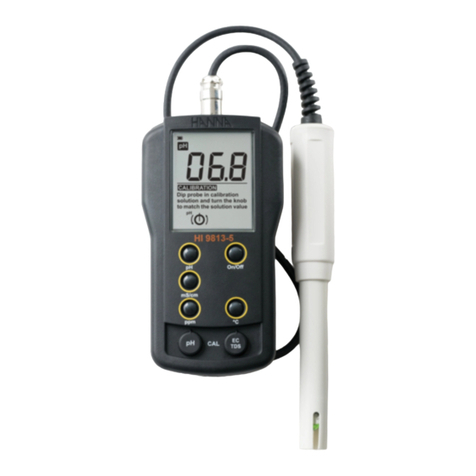
Hanna Instruments
Hanna Instruments HI 9813-5 instruction manual

Innova
Innova MRP 93-0187 owner's manual
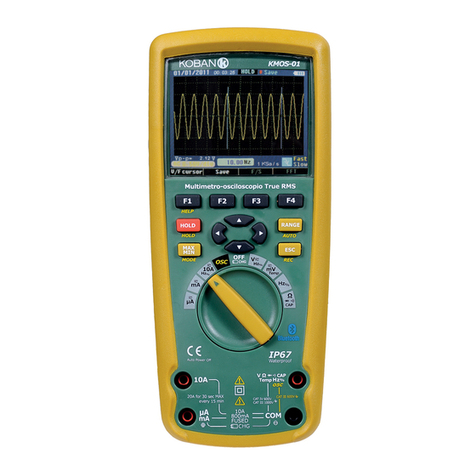
koban
koban Meterbox KMOS-01 user guide
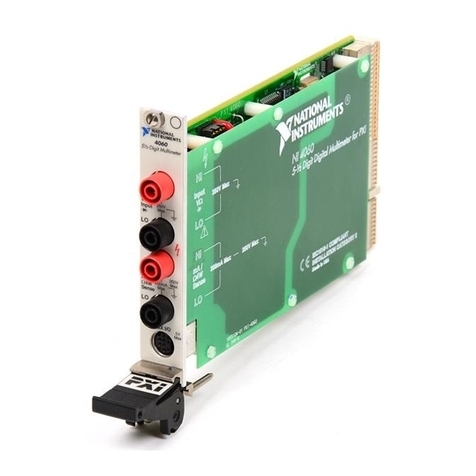
National Instruments
National Instruments NI PXI-4060 Getting started guide
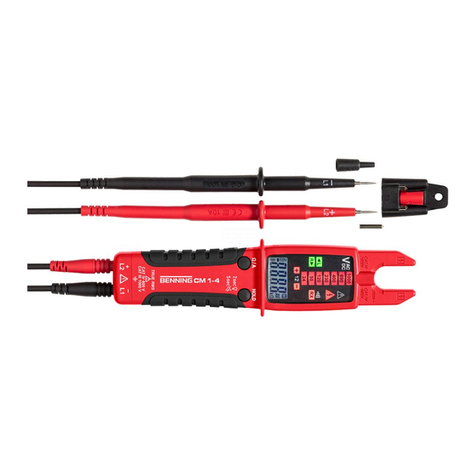
Benning
Benning CM 1-4 operating manual
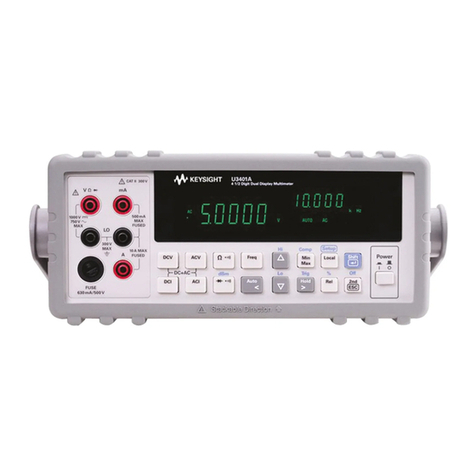
Keysight Technologies
Keysight Technologies U3401A quick start guide



